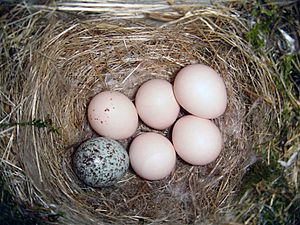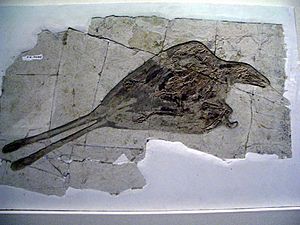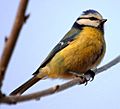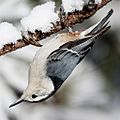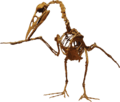Bird facts for kids
Quick facts for kids BirdsTemporal range: Upper Jurassic – Recent
|
|
|---|---|
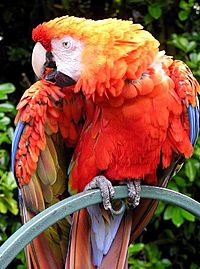 |
|
| A Scarlet macaw (Ara macao) | |
| Scientific classification | |
| Kingdom: | |
| Phylum: | |
| Subphylum: | |
| (unranked): | |
| Class: |
Aves
Linnaeus, 1758
|
Birds are amazing creatures that belong to a special group of vertebrates called the Aves. They are a unique class of animals!
Birds are different from many other animals because they are warm-blooded. This means they can keep their body temperature steady. It doesn't matter how hot or cold it is outside. Birds also lay eggs with hard shells. Their bodies are covered in soft, light feathers, and they have wings. Feathers are super important for birds. They help them fly, keep their body warm, and even help them show off to other birds. Most birds have bones that are hollow and filled with air sacs. This makes them lighter and helps them fly easily.
Birds walk on two legs, which is called bipedalism. Their legs are often covered with scales. These are small, flat plates that overlap like feathers. Instead of teeth, birds have a hard beak. Birds keep a high body temperature, so they need a lot of energy. This means they eat a lot of food compared to their size!
There are more than 9,000 different species of birds known around the world. You can find birds on every continent. They live from freezing cold places to hot deserts. Birds live in all sorts of places: forests, grasslands, on cliffs, in river banks, on stony sea shores, and even on the roofs of houses!
Birds have very different diets. Many birds are carnivorous, meaning they eat meat at least sometimes. Lots of birds eat insects or fish. Some hunt small reptiles and mice. Birds of prey like eagles eat mammals and other birds. Some birds are scavengers, eating animals that have already died. Birds like parrots and finches mostly eat seeds and fruit. Interestingly, some seed-eating birds feed their young insects. Only a few types of birds eat green plants. Just one species, the hoatzin, lives mainly on leaves. Hummingbirds and honeyeaters get their food from the sweet nectar or honey found in flowers.
Birds come in all sizes! The tiny bee hummingbird is only about 60 mm long. The huge ostrich can stand 2.5 meters tall. The bird with the widest wingspan is the wandering albatross. It can measure 3 meters from wingtip to wingtip!
All these facts apply to birds living today. But did you know that birds are actually the descendants of theropod dinosaurs? Early birds looked a lot like small carnivorous dinosaurs. We've learned so much about the origin of birds from fossils. These fossils show that some dinosaurs had feathers. Early birds like Archaeopteryx even had teeth!
Contents
- How Birds Look: Body Shapes and Adaptations
- Bird Colours: Why Birds Are So Colourful
- How Birds Fly: The Mechanics of Flight
- Bird Families: Reproduction and Raising Young
- Bird Talk: How Birds Communicate
- Bird History: Evolution and Classification
- Birds and People: Our Relationship with Birds
- Gallery of Well-Known Small Birds
- More Bird Images
- See also
How Birds Look: Body Shapes and Adaptations
Birds live all over the world. They have adapted to many different conditions. So, they come in all shapes and sizes! The biggest differences you'll notice are their overall size, the shape of their beak, the length of their legs, their neck length, and their color.
The smallest birds are tiny ones that feed on nectar, honey, and insects. The biggest birds are usually flightless birds with long legs. Examples include ostriches, emus, and cassowaries. But there are also very large birds that soar high in the sky. These include eagles, vultures, albatross, and pelicans. You can often tell a lot about a bird's lifestyle by looking at its legs, feet, beak, neck, and wings.
If a bird has very long legs, it probably spends most of its time walking. Think of a crane. Or it might wade in water, like a flamingo. Birds with long legs usually have long necks too. This helps them reach their food. Birds with short legs but long necks, like pelicans, geese, and swans, are excellent swimmers. They dive their heads into the water for food. Their beaks are often flat, perfect for scooping up water weeds. A pelican's beak can even stretch into a huge bucket shape to catch fish!
Birds shaped like torpedoes are great at diving. Albatross, seagulls, and kingfishers all have long, strong beaks for catching fish. Some birds, like eagles, owls, vultures, and hawks, have hooked beaks. They also have very large claws (called "talons"). They use these to tear and carry meat.
Some birds have very long, thin beaks. They use them for sipping from flowers or poking into holes in the ground. These include hummingbirds, bee eaters, and avocets. Other birds have short beaks but wide mouths. These are perfect for catching insects in the air. Examples are swallows, swifts, and nightjars. Birds that eat fruit, like toucans and hornbills, can have enormous but very light beaks. The curved beaks of parrots are great for eating large seeds and cracking nuts. Birds that peck small seeds from the ground have short beaks, like pigeons.
-
An ostrich has very long legs for running.
-
A pelican has a huge beak that can expand to catch fish.
-
The great hornbill is a large bird with an unusual, lightweight beak.
-
Hummingbirds include the world's smallest birds, known for their long beaks.
Bird Colours: Why Birds Are So Colourful
Birds come in an incredible range of colours! These colours help birds in two main ways. Camouflage colours help them hide. Bright colours help them recognize others of their own species. Often, the male bird is brightly coloured, while the female is camouflaged.
How Birds Use Camouflage to Hide
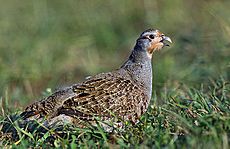
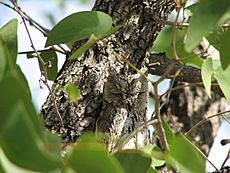
Many birds are brown, green, or grey. These colours make it harder to see them; they camouflage the bird. Brown is a very common colour. Brown birds include sparrows, emus, thrushes, larks, eagles, falcons, and the female birds of many species. When a brown bird is in long grass, among tree trunks, or on rocks, it's camouflaged. Birds that live in long grass often have brown feathers with black streaks. These look like shadows. A bittern is almost invisible in tall reeds. Other birds, like starlings and minahs, are dark but have little spots that look like raindrops on leaves.
Many birds from hot countries are green or have some green feathers, especially parrots. Birds that live in green trees often have green backs. This is true even if their chests are brightly coloured. From the back, these birds are camouflaged. This is very useful when they are sitting on a nest. Their bright chest is hidden. Budgerigars are bred in different colours like blue, white, and mauve. But in the wild, they are almost all green and yellow. Even though they fly well, they spend a lot of time on the ground eating grass seeds. Their yellow and black striped backs help them hide in the shadows of dry grass. Their green chests match the leaves of gum trees.
Grey birds include most pigeons and doves, cranes, storks, and herons. Grey birds are often rock-living birds like pigeons. Or they are birds that sit on dead tree trunks, looking like a broken branch. Water birds like herons often have a pale grey colour. This makes it harder for fish to notice them standing and looking for food. Water birds, no matter their top colour, are often white underneath. So, when a fish looks up, the bird blends in with the sky.
Black birds include crows, ravens, and male blackbirds. Some dark-coloured birds spend a lot of time on the ground. They hop in the shadows under bushes. This includes the male blackbird and the Satin Bowerbird, which is a very dark blue. Crows and ravens often perch high on bare trees in winter. There, their black shape against the sky looks like dark, bare branches.
Bright Colours: Standing Out in the Bird World
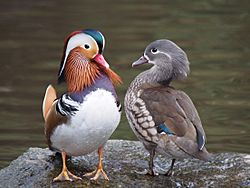
Many birds are not camouflaged but stand out with vivid colours. These are usually male birds. Their females are duller and camouflaged. The bright colours serve two purposes. First, they help males attract mates. Second, they help males identify other males of the same species. Many birds are territorial, especially during nesting season. They make sounds and are easily seen to let other males know they will defend their territory. It's like a "look elsewhere" signal to competitors.
Some birds are famous for their colour and are even named after it. Examples are the bluebird, the azure kingfisher, the golden pheasant, the scarlet macaw, the violet wren, and the robin.
Many other birds are very brightly coloured in countless combinations. Some of the most colourful birds are quite common. These include pheasants, peacocks, domestic fowl, and parrots. Colourful small birds include blue tits, goldfinches, hummingbirds, fairy wrens, and bee eaters (also called rainbow birds). Some birds, like the bird of paradise in Papua New Guinea, have such beautiful feathers that they have been hunted for them.
The peacock is a great example of using colour to attract a mate. The male domestic fowl and junglefowl also have long, shiny feathers above their tails. They have long neck feathers that might be a different colour from their wings and body. There are only a very few types of birds (like the eclectus parrot) where the female is more colourful than the male.
'Pied birds' are black and white. Examples include magpies, pied geese, pelicans, and Australian magpies (which are not true magpies). Pied birds often have brightly coloured beaks and legs of yellow or red. The silver pheasant, with its long white tail striped with fine black bars, has a brightly coloured face.
-
A King parrot from Australia.
-
A Common shelduck.
-
A vibrant Kingfisher.
-
A tall, pink Flamingo.
-
A Golden oriole.
How Birds Fly: The Mechanics of Flight
Most birds can fly! They do this by pushing through the air with their wings. The curved shape of their wings creates air currents (like tiny winds) that lift the bird. Flapping their wings keeps these air currents moving. This creates lift and moves the bird forward.
Some birds can glide on air currents without flapping. Many birds use this method when they are about to land. Some birds can also hover, staying in one place in the air. This is used by birds of prey like falcons when they are looking for food. Seagulls are also good at hovering, especially in a strong breeze. The most expert hovering birds are tiny hummingbirds. They can beat their wings both backwards and forwards. This allows them to stay perfectly still in the air while they dip their long beaks into flowers to feed on sweet nectar.
-
A flock of tundra swans flying in a V-formation.
-
This osprey at Kennedy Space Centre is hovering, looking for fish.
-
A wandering albatross can sleep while gliding in the air.
-
The large, broad wings of a vulture allow it to soar without flapping.
-
The soft feathers of an owl allow it to fly quietly, helping it hunt at night.
-
Some birds, like the quail, spend most of their time on the ground.
-
A cassowary cannot fly but can defend itself with powerful kicks.
-
Penguins use their wings like flippers for swimming underwater.
Different Ways Birds Fly
Different types of birds have different needs. Their wings are adapted to suit how they fly.
Large birds of prey, like eagles, spend a lot of time soaring on the wind. They have large and broad wings. Their main flight feathers are long and wide. These wings help the eagle stay on rising air currents without using much energy. Meanwhile, the eagle looks at the ground below for its next meal. When an eagle spots something small moving, it can close its wings and drop from the sky like a missile. It opens its great wings again to slow down as it lands. The world's largest eagle, the Philippine eagle, has a wingspan of about 2 metres (6.7 ft) wide.
Birds that live in grasslands or open forests eat fruit, insects, and reptiles. They often fly short distances looking for food and water. Their wings are shaped similarly to eagles' but are rounder. They are not as good for soaring. This includes many Australian birds like cockatoos.
Birds like geese that migrate from one country to another fly very long distances. Their wings are big and strong because the birds are large and store up food for the long flight. Migrating water birds usually form family groups of 12-30 birds. They fly very high, using long streams of air that blow from north to south in different seasons. They are very organized, often flying in a V pattern. The geese at the back don't have to flap as hard. They are pulled along by the wind created by the ones at the front. Every so often, they change the leader. This way, the front bird, who does the most work and sets the pace, can rest. Geese and swans are among the highest-flying birds. They can reach 8,000 metres or more during migration. Geese often honk loudly while flying. This is thought to support the leader and help the young ones.
Birds that fly very quickly, such as swifts and swallows, have long, narrow, pointed wings. These birds need great speed because they catch most of their insect food while flying. These birds also migrate. They often gather in huge flocks of thousands of birds. They move together like a whirling cloud.
Birds that live in bushes and branches have triangular wings. These help them change direction quickly. Many forest birds are experts at gaining speed by flapping and then gliding steadily among the trees. They tilt to avoid obstacles as they go. Members of the kingfisher family are excellent at this type of flying.
Birds like owls that hunt at night have wings with soft, rounded feathers. This way, they don't flap loudly. Birds that are awake at night are called nocturnal birds. Birds that are awake during the day are diurnal.
A wandering albatross and Arctic tern might spend several years without coming to land. They can sleep while gliding. Their wings, when fully stretched out, look like the wings of a jet plane.
Birds like chickens that feed mainly on the ground only use their wings to fly to safety. They have small wings.
Birds in Flocks: Teamwork in the Sky
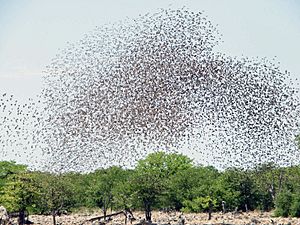
Flocks of birds can be very highly organized. They take care of all their members. Studies of small flocking birds like tree sparrows show that they communicate clearly with each other. Sometimes, thousands of birds may fly in close formation and spiral patterns. They do this without colliding (flying into each other).
Two common behaviours in flocking birds are guarding and reconnaissance. When a flock of birds is feeding, it's common for one bird to perch in a high place. It keeps guard over the flock. Similarly, when a flock is asleep, often one bird will remain awake. It's also common for large flocks to send one or two birds ahead when they are flying to a new area. These "look-out" birds can scout the lie of the land. They look for food, water, and good places to perch.
Birds That Don't Fly: Flightless Wonders
Some birds don't fly at all! These include running birds like ostriches and emus. Also, ocean-living birds, the large penguin family, don't fly.
Ostriches and emus don't need to fly. Their great size and speed protect them. Some other ground-feeding birds haven't been so lucky. Birds like the dodo and the kiwi were ground-feeding birds. They lived safely on islands where there were no dangerous predators. They lost the ability to fly. Kiwis are endangered because European settlers in New Zealand brought animals like cats, dogs, and rats. These animals kill kiwis and eat their eggs. However, kiwis and the rare New Zealand ground parrot have survived. In the case of dodos, they were large and easy to catch. Sailors hunted and ate them until none were left. Other flightless birds that have disappeared include the great auk and the moa.
Penguins spend a lot of time at sea. There, they face dangers from seals. On land, they usually lived in areas with few dangers. This changed when European settlers arrived with dogs and cats. Their wings have adapted to life in the sea. They have become flippers, which help them swim very fast.
Bird Families: Reproduction and Raising Young

Mating and Choosing Partners
Even though birds are warm-blooded like mammals, they don't give birth to live babies. Instead, they lay eggs, just like lizards do. But unlike most reptiles, a bird's egg has a hard shell. The baby bird grows inside the egg. After a few weeks, it breaks out, or hatches.
Birds in cold climates usually have a breeding season once a year in the spring. Migratory birds can sometimes have two springs and two mating seasons in a year. This can also happen with birds that live in hot climates.
When the breeding season arrives, birds choose partners. Some birds mate for life, like married couples. These include pigeons, geese, and cranes. Other birds look for new partners each year. Sometimes a male bird, or cock, will have several wives.
For birds that choose new mates, part of the breeding season involves display. The male bird will do all sorts of things to attract females. This can include singing, dancing, showing off his feathers, and building a beautiful nest. Some male birds have splendid feathers just for attracting females. The most famous is the peacock. He can spread the feathers above his tail into a huge, colourful fan.
-
A peacock displaying his magnificent tail feathers.
-
The sarus crane, like most cranes, mates for life and pairs dance together.
-
An Emu nest with large, dark green eggs.
-
A nest of house sparrows with hungry chicks.
Building Nests and Laying Eggs
Once birds have found partners, they find a suitable place to lay eggs. What's "suitable" differs greatly between species. But most build bird nests. Robins make beautiful little round nests of woven grass. They carefully line them with feathers, bits of fluff, and other soft things. Swallows like to nest near other swallows. They make nests from small blobs of clay, often on a beam near the roof of a building where it's sheltered. Many birds like a hollow tree to nest in. Eagles' nests are often just piles of dead wood on the top of the tallest tree or mountain. Scrub turkeys scratch together a huge pile of leaves that may be 10 metres across. Guillemots lay their eggs on rock shelves with no nest at all! Their eggs are shaped so they roll in circles and don't fall off cliffs. A cuckoo doesn't make its own nest. It lays its egg in the nest of another bird and leaves it for them to care for. Cuckoo eggs are camouflaged to look like the host's eggs.
After the nest is ready, the birds mate so the eggs are fertilized and the chicks will start growing. A female bird, called a hen, usually has two ovaries, but only the left one typically produces eggs. Most male birds don't have visible sex organs. But inside the male are two testes which produce sperm. Birds mate by rubbing their cloacas (a single opening for waste and reproduction) together.
Hatching and Raising Chicks
Once the hen has mated, she produces fertile eggs with chicks growing inside them. She lays the eggs in the nest. There might be just one egg or a number of them, called a clutch. Emus might lay as many as fifteen huge, dark green eggs in a clutch. After the eggs are laid, they are incubated, or kept warm. This helps the chicks develop inside. Most birds stay together for the whole nesting season. One advantage is that the work is shared. Many birds take turns sitting on the eggs, so each adult can feed.
This isn't always the case. With emus, the male does all the sitting and all the baby-minding. With emperor penguins, it's also the male that cares for the egg. There's only one egg, which he keeps on his feet and under his feathers. He stands in a big group of males without feeding until the chick hatches. While the eggs are hatching, the females are at sea, feeding. This way, they can care for the chicks when they return.
Some birds put their eggs inside or on top of a mound of leaves and twigs. This mound acts like a compost heap. The decomposition of the rotting leaves causes the temperature to rise. This heat is released by the chemical action of bacteria and fungal respiration. It's the same reaction that keeps mammals and birds warm. The parents leave the mound. When the chicks hatch, they are able to feed themselves.
Many small birds take 2–4 weeks for their eggs to hatch. Albatrosses take a long 80 days! During this time, the female loses a lot of body weight.
The quickest hatching time is for the cuckoo. Some types of cuckoos take only 10 days. This means that when they hatch in the nest of their 'foster parents', the eggs the parents laid aren't ready yet. Newborn cuckoos are naked, blind, and might look ugly. But they are strong! They get under any other eggs in the nest and throw them out before they hatch. This means the cuckoo gets the full care of both parents. Baby cuckoos grow fast and often become bigger than the parents who feed them!
When baby birds hatch, in most types of birds, they are fed by both parents. Sometimes, older "aunties" help as well. Their mouths are open all the time and are often very brightly coloured. This acts as a 'releaser', a signal that stimulates the parent to feed them. For birds that eat grain and fruit, the parents eat and partly digest the food for the babies. It is then carefully vomitted into the baby's mouth.
-
A Black swan and its cygnets.
-
A reed warbler feeding a baby cuckoo that is much larger than itself.
-
Two sulphur-crested cockatoos from a big flock are on the lookout.
Growing Up: From Chicks to Fledglings
Many birds, especially those that mate for life, are very social. They stay together in a family group. This group might be anything from 4 or 6 adult birds and their young to a very large flock.
As chicks grow, they lose the fluffy down that covers them as babies. They grow real feathers. At this stage, they are called fledglings. Other family members may help care for fledgling chicks. They feed them and protect them from attack while the parents are feeding. When the fledglings have their new feathers, they come out of the nest to learn to fly. In some types of birds, like pigeons, the parents watch over this process. As the young ones get stronger, the parents give them flying lessons. They teach them how to glide, how to fly in spirals, and how to land like an expert!
Bird Talk: How Birds Communicate
Most birds are social animals, at least part of the time. They communicate with each other using sounds and displays.
Almost all birds make sounds to communicate. The types of noises vary greatly. Some birds can sing, and they are called songbirds. Examples include robins, larks, canaries, thrushes, nightingales, and crows. Birds that are not songbirds include pigeons, seagulls, eagles, owls, and ducks. Parrots are not songbirds, even though they can be taught to sing human songs.
-
A favourite songbird, the European robin.
-
The crow of the rooster is a familiar bird call.
-
The pied currawong, an outstanding singer.
-
Jackdaws helped Konrad Lorenz understand bird communication.
The World of Songbirds
All birds make noises (called 'bird vocalization'), but not all of them sing. Songbirds are a group called passerines. Many of them have beautiful, melodic songs. Songs have different purposes. Danger cries are different from territorial songs. Mating calls are a third type. Fledglings may also have different calls from adults. Recognition calls for partners are quite common.
When it comes to where the song comes from, there are three kinds of species:
- Those where the song is entirely inherited. The bird always sings the same song in the same situations.
- Those where the song is partly inherited. But the bird fine-tunes it by copying others. In this case, slight differences between the calls of different birds may be used by partners for identification.
- Those where the song is entirely learned. The bird often copies sounds from its environment.
Most singing birds kept as pets, like canaries, have several tunes and some variations.
The same species of bird will sing different songs in different regions. A good example is the currawong. This is an Australian bird that looks like a black and white crow. In the autumn, families gather in large flocks and do a lot of singing. Currawongs from some areas sing much more complex songs than others. Generally, currawongs from the Blue Mountains are considered the finest singers. The currawong's song can be sung as a solo. But it's often performed as a choir. One bird will take the lead and sing "Warble-warble-warble-warble!" All the other birds will join in and sing "Wooooooo!" When all the birds know the song, the choir will sing the "Warble" part, and the soloist will sing the "Woo!". The song changes from year to year and from place to place.
Konrad Lorenz and Bird Communication
The Austrian naturalist Konrad Lorenz studied how birds communicate, or "talk" to each other. He found that each type of bird had a number of sounds they made automatically whenever they felt a certain way. Every sound had an action that went with it. So, if a bird was frightened, it acted frightened and made a frightened sound. This told the other birds around it that something scary was happening.
If a flock of birds was flying over a field, they might be calling "Fly! Fly!" But a hungry bird, seeing something good to eat below, might start calling "Food! Food!" If other birds were also hungry, they would make the same call. This would continue until more birds were calling "Food! Food!" than "Fly! Fly!". At this point, the "mind" of the flock would change. Some birds would start to yell "Fly downwards! Fly downwards!" as they dropped from the sky. This would continue until the whole flock was noisily calling the same thing.
These communication sounds are often short, sharp sounds. Examples are chirps, squeaks, squawks, and twitters. Sometimes the calls are longer and more musical. They include the "Rookety-coo" sound of a pigeon and the "Cockadoodledoo!" of a rooster. The bird cannot change these sounds. They always make them in the same way. The bird is "locked into" making each sound every time a particular idea comes into its head. The connection between how they feel and how they call is innate: they are born with it. Some calls in some species are learned. But then it's the tendency to learn that is inherited.
The Jackdaw of Altenberg
Konrad Lorenz noticed that when birds sing, they often use many of their regular calls as part of the song. Lorenz had a flock of jackdaws that were scattered during World War II. One day, an old bird returned. For many months, she sat on the chimney singing her song. But in the song, she kept making the call that Lorenz knew meant "Come home! Come home!" One day, to Lorenz's great surprise, a male bird flew from a passing flock and joined her on the chimney. Lorenz was sure that it was her long-lost "husband" who had finally found his way home.
Bird History: Evolution and Classification
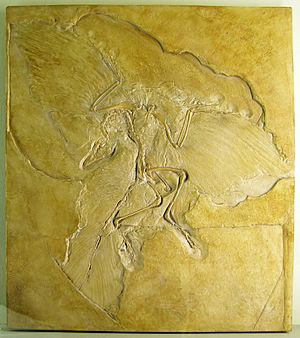
Palaeontologists (scientists who study fossils) have found some amazing places (called lagerstätten). There, fossils of early birds are preserved incredibly well. The preservation is so good that on the best examples, you can see impressions of their feathers. Sometimes, you can even see the remains of meals they ate! From these remains, we know that birds evolved from small carnivorous dinosaurs (called theropods) during the Jurassic period. They quickly diversified into a huge variety in the Lower Cretaceous. At the same time, their direct competitors, the pterosaurs, became fewer in number and variety. They eventually became extinct at the end of the Mesozoic Era.
Birds are classified by taxonomists as 'Aves' (Avialae). Birds are the only living descendants of dinosaurs. So, strictly speaking, they are dinosaurs! Birds and Crocodilia (crocodiles and alligators) are the only living members of the once-dominant Archosaur reptiles.
The class Aves is now defined as all the descendants of the most recent common ancestor of modern birds and Archaeopteryx lithographica.
The First Bird-like Creatures
Archaeopteryx, from the Upper Jurassic period (about 150–145 million years ago), is the earliest bird that could fly. It's famous because it was one of the first important fossils found after Charles Darwin published his ideas about evolution in the 19th century. By today's standards, Archaeopteryx wasn't a very good flyer. Other early fossil birds include Confuciusornis, Anchiornis huxlei, and other Paraves.
Many fossils of early birds and small dinosaurs have been discovered in the Liaoning Province of Northeast China. These fossils show that most small theropod dinosaurs had feathers. These deposits have preserved them so well that the impressions of their feathers can be clearly seen. This makes us think that feathers first evolved to help with heat insulation. Only later did they evolve for flight. The origin of birds lies in these small feathered dinosaurs.
Palaeontologists now agree that birds evolved from the Maniraptora group of dinosaurs. This is why you might hear people say birds are living dinosaurs!
Birds and People: Our Relationship with Birds
-
Canaries are often kept as pets for their beautiful songs.
-
The African grey parrot is known for its ability to copy human speech.
-
Blue-winged teal. Ducks used to be hunted for sport.
-
In many countries, storks are thought to bring good luck.
Some birds are eaten as food. Most commonly, it's the chicken and its eggs. But people also often eat geese, pheasants, turkeys, and ducks. Other birds sometimes eaten include emus, ostriches, pigeons, grouse, quails, doves, woodcocks, and even songbirds. Some species have died out because they were hunted too much for food. Examples are the dodo and the passenger pigeon.
Many bird species have learned how to get food from people. The number of these birds has grown because of this. Seagulls and crows find food from garbage dumps. The feral pigeon (Columba livia), sparrows (Passer domesticus), and starlings (Sturnus vulgaris) live in large numbers in towns and cities all over the world.
Sometimes people use birds for work. For example, homing pigeons used to carry messages. Nowadays, people sometimes race them for sport. People also use falcons for hunting, and cormorants for fishing. In the past, miners often used a canary to detect dangerous gases like methane in the air.
People often keep colourful birds like parrots and mynahs as pets. These intelligent birds are popular because they can copy human speech. Because of this, some people used to trap birds and take them to other countries to sell. This is usually not allowed these days. Most pet birds are specially bred and sold in pet shops.
People can catch some bird diseases, such as psittacosis, salmonellosis, campylobacteriosis, Newcastle's disease, mycobacteriosis, influenza, giardiasis, and cryptosporidiosis. In 2005, there was an epidemic of bird influenza spreading through some parts of the world, often called avian flu.
Some people put birdboxes in their gardens to give birds a place to nest. They also put out bird tables where birds can get food and water in very cold or very dry weather. This lets people see small birds up close that are normally hidden away in bushes and trees.
Gallery of Well-Known Small Birds
More Bird Images
-
Archaeopteryx lithographica is often considered the oldest known true bird.
-
Anchiornis huxleyi is an important source of information on the early evolution of birds in the Late Jurassic period.
-
Confuciusornis sanctus, a Cretaceous bird from China that lived 125 million years ago, is the oldest known bird to have a beak.
-
Ichthyornis, which lived 93 million years ago, was the first known prehistoric bird relative preserved with teeth.
-
A model of a bird's heart.
-
The nictitating membrane (a clear eyelid) as it covers the eye of a masked lapwing.
-
A Red lory preening its feathers.
-
A Restless flycatcher in the downstroke of flapping flight.
-
A flock of Canada geese flying in a V formation.
-
The routes of satellite-tagged bar-tailed godwits migrating north from New Zealand. This species has the longest known non-stop migration of any species, up to 10,200 km (6,300 mi).
-
The startling display of the sunbittern mimics a large predator to scare off threats.
-
Many birds, like this American flamingo, tuck their head into their back when sleeping.
-
Nest of an eastern phoebe that has been parasitised by a brown-headed cowbird.
-
A female calliope hummingbird feeding fully grown chicks.
-
Altricial chicks (meaning they are helpless at birth) of a white-breasted woodswallow.
-
A Gran Canaria blue chaffinch, an example of a bird highly specialised in its habitat, in this case in the Canarian pine forests.
-
Painted tiles with bird designs from the Qajar dynasty.
-
The California condor once numbered only 22 birds, but conservation measures have raised that to over 500 today.
See also
 In Spanish: Aves para niños
In Spanish: Aves para niños

























